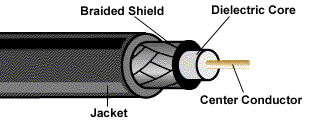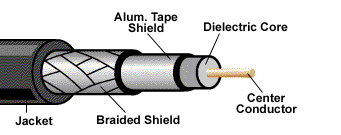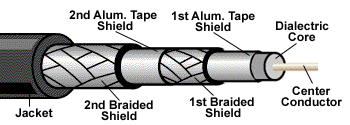|
Coaxial Cable
Handbook
In
recent years, coaxial cables have become an essential
component of our information superhighway. They
are found in a wide variety of residential, commercial
and industrial installations. From broadcast, community
antenna television (CATV), local area network (LAN),
closed circuit television (CCTV) to many other applications,
coax has laid the foundation for a simple, cost
effective communications infrastructure.
|
| History |
 |
Government
and military applications summoned in the initial
development of coaxial cables. Built to military
specifications and classified according to Radio
Guide Utility numbers, these products were developed
to help support high frequency radio transmissions.
After some time, these “RG/U” numbers
fell into classifications according to impedance
characteristics. The steady growth of the computer
industry further developed the need for coaxial
cables for commercial use. Manufacturers of “proprietary”
system demanded a variety of unique cable designs.
|
| Conductors |
 |
|
Depending upon
the application, many different types of conductor constructions may
be found in coaxial cables.
Solid Conductors
Solid copper conductors are popular on many CCTV installations. Solid
conductors provide less chance for distortion and line loss than copper
covered steel. However, copper is a soft material and will break if
repeatedly flexed. It is best used on permanent installation.

Stranded
Conductors
Many small strands of copper can be used to make up any gauge size.
Stranded conductors provide increased flexibility over solid conductors.
This design has become popular for use on pan and tilt cameras, robotics
and other applications that require repeated flexing.

Copper-Covered
Steel Conductors
In some applications strength is a key requirement. Steel conductors
covered with copper may be needed to prevent breakage in an active
environment. Copper covered steel conductors provide added strength
and RF support and are often used in CATV and MATV applications.

|
| The Dielectric |
 |
|
The inner conductor of a coaxial cable is separated by an insulating
material from the surrounding shield(s). This “dielectric”
material is often chosen in order to maintain consistent electrical
properties and minimize signal loss. The result is a clear, trouble
free transmission.
| Coaxial Cable |

|
Note:
foamed dielectric materials provide a lightweight composition suitable
for many coaxial constructions. Foaming the dielectric also contributes
to increased clarity in high speed transmissions.
Popular Dielectric
Materials include:

PE-Solid Polyethylene: good for low temperature
applications.
FPE-Foamed Polyethylene: provides lower attenuation
and capacitance than solid PE.
Air Spaced: supports a lower dielectric constant
than Polyethylene while allowing for a small diameter cable size.
FEP-Fluorinated Ethylene Propylene: excellent
for high temperature and plenum applications. Low dielectric constant
for clear signal transmission.
FFEP-Foamed Fluorinated Ethylene Propylene:
extremely low dielectric constant.
|
| Shielding |
 |
|
In coaxial applications,
shielding is an important part of the overall composition of the cable.
Shielding not only protects the loss of signal in high frequency application,
but also helps to prevent EMI (electromagnetic interference) and RFI
(radio frequency interference) in the circuit. There are three popular
types of shielding: overall foil, braid and foil/braid.
Foil Shield
Foil shields are commonly used as an effective, low cost application
to prevent EMI/RFI interference. The construction consists of a layer
of aluminum with a polyester backing that is overlapped to provide
100% coverage.
Braid Shield
Braid shields are constructed of thin strands of aluminum, tinned
copper or bare copper that are interwoven. Many different coverages
are available with 40-67% aluminum and 95% copper being the most popular.
High percentage braided shields offer an excellent protection from
EMI and RFI and are popular in CCTV applications.
| Coax Cable |

|
Foil/Braid
Shield
Foil/braid shielding is extremely popular with CATV and MATV applications.
The 100% aluminum foil is accompanied by a braided shield to provide
improved protection from EMI and RFI.
| Dual Shield Coax Cable |
 |
Tri-Shield
Construction consists of a foil-braid-foil shield.
Quad-Shield
Construction consists of a foil-braid-foil-braid shield. Very popular
for CATV and MATV applications in high EMI/RFI locations such as urban
areas.
| Quad Shield Coax Cable |
 |
|
| The Jacket |
 |
| The outer sheath found on most coaxial cables is called the jacket.
The main function of the jacket is for protection from the environment
and as an additional form of insulation. The compounds used to make
the jacket may have different temperature ratings. The temperature rating
of a cable, along with the location rating (i.e. plenum, wet, sunlight
resistant etc.) will determine the minimum or maximum operating temperature
of the cable. In today’s multi-application world, many jacketing
choices exist:
PVC-Polyvinyl
Chloride: Very flexible thermo-plastic material commonly
used on general purpose coaxial products. Temperature rating: -40
to 80ŪC.
PE-Polyethylene:
A thermoplastic material which exhibits excellent electrical properties.
Often used in direct burial applications. Temperature rating: -55
to 85ŪC.
FEP-Fluorinated
Ethylene Propylene:
A thermoplastic material with good
insulating properties. Excellent in high temperature, plenum and chemical
environments. Temperature rating: -50 to 200ŪC
|
|
|
|
|